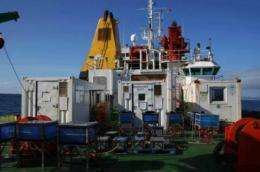Iron controls patterns of nitrogen fixation in the Atlantic

Scientists including researchers from the National Oceanography Centre, Southampton and the University of Essex have discovered that interactions between iron supply, transported through the atmosphere from deserts, and large-scale oceanic circulation control the availability of a crucial nutrient, nitrogen, in the Atlantic. Their findings have potentially important implications for understanding global climate, both past and future.
Nitrogen is an essential element for life, but in its gaseous form (N2) cannot be used by most organisms. To be useful, nitrogen has to be 'fixed' by combining it with other chemicals to form compounds such as ammonium. 'Diazotrophic' microbes such as the blue-green bacterium Trichodesmium are equipped with the enzymes needed to perform these energy-demanding transformations.
Nevertheless, over most of the ocean, a relative shortage of fixed nitrogen limits the growth of phytoplankton - microscopic marine plants - and their uptake of the greenhouse gas carbon dioxide through photosynthesis. Fixed nitrogen is ultimately removed by denitrification, whereby it is converted back to N2. The rate at which it is replaced depends on many factors including the availability of other crucial nutrients such as iron and phosphate needed by nitrogen-fixing microbes for growth.
Work over the last decade or so has hinted at iron availability being a significant control on oceanic nitrogen fixation, primarily because the enzyme responsible contains a lot of this element. However, other recent research had reinforced the long held view that phosphorus is the more important controlling factor. The new findings reaffirm the view that an adequate supply of iron is crucial, which, although frequently quoted, had previously been supported by little clear evidence.
"Our new data provides some of the first really conclusive evidence that iron availability is playing a significant roll in controlling the input of fixed nitrogen, at least to the Atlantic Ocean," said lead author Dr Mark Moore of the University of Southampton's School of Ocean and Earth Science based at the National Oceanography Centre.
Detailed measurements of nutrients and microbiology were made by an international team aboard the Royal Research Ship RRS Discovery during a 10,000-kilometre cruise along a meridional transect between 37N - 35S in the Atlantic Ocean in 2005.
Iron-rich dust blown over the North Atlantic from the Sahara desert allows the growth of diazotrophic Trichodesmium species, which fix large amounts of nitrogen and use up excess phosphate. In contrast, diazotrophs in the South Atlantic appear more severely limited by iron availability.
These observations, backed up by a large-scale physical analysis of the Atlantic circulation, also indicated that the North Atlantic is a net source of fixed nitrogen to the world's oceans.
In addition to highlighting the importance of iron in controlling global patterns of nitrogen fixation, the potential for interaction with the overturning circulation leads to novel conclusions concerning the global nitrogen cycle.
Specifically, it appears that nitrogen fixation in the north Atlantic basin, immediately upstream of the formation region for half the global deep waters, will have a much greater influence on ocean-atmosphere partitioning of carbon dioxide than recently proposed hotspots of nitrogen fixation around the edges of denitrification zones.
"Any interactions between large-scale overturning circulation and nitrogen fixation may potentially have important consequences for understanding how the nitrogen cycle reacted to past climate change, and also how it might react in the future," says Dr Moore.
He acknowledges, however, that there is still a lot of work to be done and that many of the details concerning the supply of nutrients for nitrogen fixation remain to be worked out: "We still need to identify the sources of iron which are presumably required to support nitrogen fixation in other regions, alongside making further improvements to our understanding of how oceanic circulation supplies the required excess phosphorus."
But what is clear from the study is that past and future climate changes in both atmospheric dust transport and ocean circulation may impact the fixed nitrogen inventory and consequently have a global-scale influence on the ability of the ocean to sequester carbon dioxide.
More information: Moore, C. M., et al. Large-scale distribution of Atlantic nitrogen fixation controlled by iron supply. Nature Geoscience. Published online 1 November 2009; dx.doi.org/10.1038/Ngeo667
Source: National Oceanography Centre, Southampton














